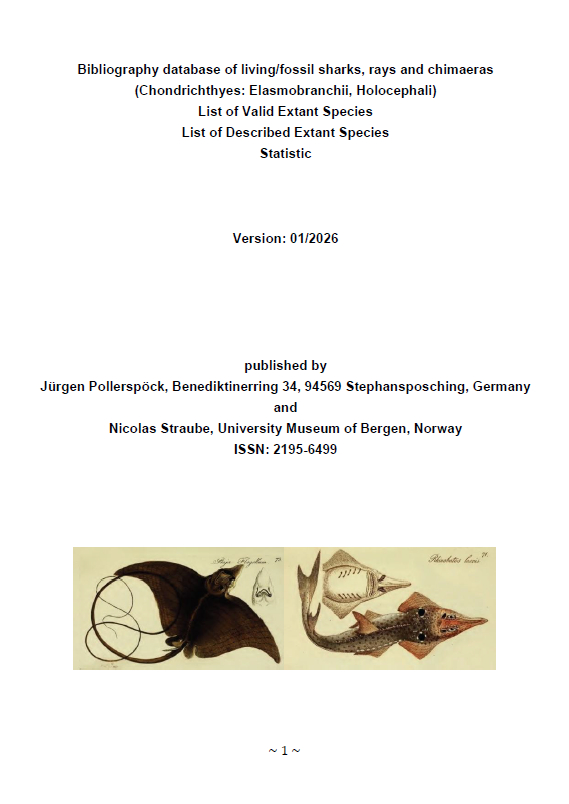Anotodus retroflexus
(Agassiz, 1838)
Classification: Elasmobranchii Lamniformes Alopiidae
Reference of the original description
Recherches sur les poissons fossiles, 11th livraison (November 1838). Petitpierre et Prince (text) and H. Nicolet (plates), Neuchâtel, vol. 3: [73]-140, pl. 1a, 8a, 8b, 15, 17, 19, 20, 24, 25b, 30, 31, 32, 33, 34, 35, 39, 40.
Recherches sur les poissons fossiles, 11th livraison (November 1838). Petitpierre et Prince (text) and H. Nicolet (plates), Neuchâtel, vol. 3: [73]-140, pl. 1a, 8a, 8b, 15, 17, 19, 20, 24, 25b, 30, 31, 32, 33, 34, 35, 39, 40.
Types
Anotodus retroflexus
Anotodus retroflexus
Description:
Citation: Anotodus retroflexus (Agassiz, 1838): In: Database of fossil elasmobranch teeth www.shark-references.com, World Wide Web electronic publication, Version 01/2026
Remarks
shark-references Species-ID=271;
valid after Szabó et al. (2021) p. 403 [30347];
synonym of Isurus retroflexus after Reinecke et al. (2011) p. 40 [13836]; Höltke et al. (2020) p. 17 [29178];
Links: Original description of Agassiz Recherches sur les Poissons Fossiles (1833-1843)
shark-references Species-ID=271;
valid after Szabó et al. (2021) p. 403 [30347];
synonym of Isurus retroflexus after Reinecke et al. (2011) p. 40 [13836]; Höltke et al. (2020) p. 17 [29178];
Links: Original description of Agassiz Recherches sur les Poissons Fossiles (1833-1843)
References

Fossil chondrichthyans of the Carpathian-Pannonian Region (in Hungarian: A Kárpát-Pannon-térség fosszilis porcoshalai). Hungarian Natural History Museum, Dabasi Nyomda Zrt., Budapest. 255 pages, ISBN 978-963-9877-52-8

New records and specimens to the Badenian fish fauna of Nyirád (Hungary), including the first report of Galeocerdo cuvier from the Middle Miocene of Europe. Fragmenta Palaeontologica Hungarica, 38, 53–74
DOI: 10.17111/FragmPalHung.2023.38.53
A diverse Miocene fish assemblage (Chondrichthyes and Osteichthyes) from the Pécs-Danitzpuszta sand pit (Mecsek Mts, Hungary). Földtani Közlöny, 151(4), 363–410
DOI: 10.23928/foldt.kozl.2021.151.4.363

Op fossielenzoektocht in de Touraine (Midden-Frankrijk). Afzettingen WTKG, 42(3), 80–88

Climate cooling and clade competition likely drove the decline of lamniform sharks. Proceedings of the National Academy of Sciences of the United States of America, 116(41), 20584–20590
DOI: 10.1073/pnas.1902693116
Neogene Caribbean elasmobranchs: diversity, paleoecology and paleoenvironmental significance of the Cocinetas Basin assemblage (Guajira Peninsula, Colombia). Biogeosciences, 16, 33–56
DOI: 10.5194/bg-16-33-2019
Shark and ray diversity in the Tropical America (Neotropics)—an examination of environmental and historical factors affecting diversity. PeerJ, 6, Article e5313
DOI: 10.7717/peerj.5313
Miocene (Burdigalian) seawater and air temperatures estimated from the geochemistry of fossil remains from the Aquitaine Basin, France. Palaeogeography, Palaeoclimatology, Palaeoecology, 481, 14–28
DOI: 10.1016/j.palaeo.2017.04.024

Pisces. In Piller, W.E. (ed.) Catalogus Fossilium Austriae, Band 3 - Verlag der Österreichischen Akademie der Wissenschaften, Wien, ISBN13: 978-3-7001-7238-3, 576 pp.

Les Chondrichthyens du Miocène moyen (Serravallien) de Salles (Gironde, France). Cossmanniana, 13, 59–79

Palaeontological study of the Order Lamniformes in the Miocene Mediterranean Basin. Thesis, University of Pisa

Haaien- en roggentanden uit Liessel (N.-B.) Fontys Hogescholen, Tilburg

Fossiele haaietanden uit het Tertiair van Cadzand. Grondboor & Hamer, 49(3/4), 51–53


Fossiles de Belgique. Dents de Requins et de Raies du Tertiaire de la Belgique. Institut royal des Sciences naturelles de Belgique, 184 pp.

Fossilen uit het 4'te Havendok by Kallo, Belgie. Geologisch Museum Universiteit van Amsterdam: 1–111, 24 pls., 1 tab. [in Dutch]

Stand der Untersuchungen an der Chondrichthyes-Fauna des nordwestdeutschen Tertiärs. Beiträge zur regionalen Geologie der Erde, 18, 503–509


Haaie- en Roggentanden uit het Tertiair van Belgie. Institut royal des Sciences naturelles de Belgique, 1–171

Fossil chondrichthyans of the Carpathian-Pannonian Region (in Hungarian: A Kárpát-Pannon-térség fosszilis porcoshalai). Hungarian Natural History Museum, Dabasi Nyomda Zrt., Budapest. 255 pages, ISBN 978-963-9877-52-8

New records and specimens to the Badenian fish fauna of Nyirád (Hungary), including the first report of Galeocerdo cuvier from the Middle Miocene of Europe. Fragmenta Palaeontologica Hungarica, 38, 53–74
DOI: 10.17111/FragmPalHung.2023.38.53
A diverse Miocene fish assemblage (Chondrichthyes and Osteichthyes) from the Pécs-Danitzpuszta sand pit (Mecsek Mts, Hungary). Földtani Közlöny, 151(4), 363–410
DOI: 10.23928/foldt.kozl.2021.151.4.363

Op fossielenzoektocht in de Touraine (Midden-Frankrijk). Afzettingen WTKG, 42(3), 80–88

Climate cooling and clade competition likely drove the decline of lamniform sharks. Proceedings of the National Academy of Sciences of the United States of America, 116(41), 20584–20590
DOI: 10.1073/pnas.1902693116
Neogene Caribbean elasmobranchs: diversity, paleoecology and paleoenvironmental significance of the Cocinetas Basin assemblage (Guajira Peninsula, Colombia). Biogeosciences, 16, 33–56
DOI: 10.5194/bg-16-33-2019
Shark and ray diversity in the Tropical America (Neotropics)—an examination of environmental and historical factors affecting diversity. PeerJ, 6, Article e5313
DOI: 10.7717/peerj.5313
Miocene (Burdigalian) seawater and air temperatures estimated from the geochemistry of fossil remains from the Aquitaine Basin, France. Palaeogeography, Palaeoclimatology, Palaeoecology, 481, 14–28
DOI: 10.1016/j.palaeo.2017.04.024

Pisces. In Piller, W.E. (ed.) Catalogus Fossilium Austriae, Band 3 - Verlag der Österreichischen Akademie der Wissenschaften, Wien, ISBN13: 978-3-7001-7238-3, 576 pp.

Les Chondrichthyens du Miocène moyen (Serravallien) de Salles (Gironde, France). Cossmanniana, 13, 59–79

Palaeontological study of the Order Lamniformes in the Miocene Mediterranean Basin. Thesis, University of Pisa

Haaien- en roggentanden uit Liessel (N.-B.) Fontys Hogescholen, Tilburg

Fossiele haaietanden uit het Tertiair van Cadzand. Grondboor & Hamer, 49(3/4), 51–53


Fossiles de Belgique. Dents de Requins et de Raies du Tertiaire de la Belgique. Institut royal des Sciences naturelles de Belgique, 184 pp.

Fossilen uit het 4'te Havendok by Kallo, Belgie. Geologisch Museum Universiteit van Amsterdam: 1–111, 24 pls., 1 tab. [in Dutch]

Stand der Untersuchungen an der Chondrichthyes-Fauna des nordwestdeutschen Tertiärs. Beiträge zur regionalen Geologie der Erde, 18, 503–509


Haaie- en Roggentanden uit het Tertiair van Belgie. Institut royal des Sciences naturelles de Belgique, 1–171
















